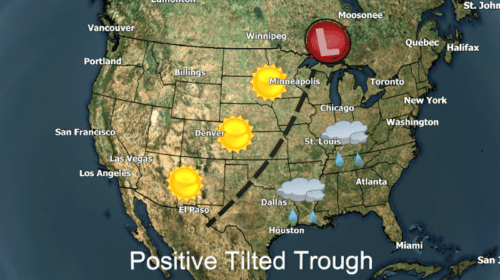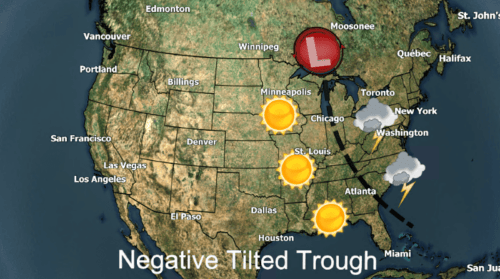Weather Troughs: Formations, Impacts, and Types
Weather troughs are significant meteorological phenomena that can have an effect in shaping our planet’s climate and influencing various weather patterns. As such, it can be useful for business leaders and decision makers to learn about troughs, and more importantly, have insights into the potentially severe weather that can result from them. In this blog post, we will delve into what weather troughs are, the different types of troughs that occur in our atmosphere, how they form, the difference between troughs and fronts, the type of weather associated with troughs, and how the resulting weather impacts businesses.
In Summary:
- Weather Troughs: Elongated regions of low atmospheric pressure that lead to rising air, cloud formation, and potential precipitation.
- Trough Types: Positively tilted troughs are less likely to cause severe weather, while negatively tilted troughs are more associated with severe weather events.
- Formation & Impact: Troughs form when air masses converge and rise, leading to distinct weather patterns like temperature fluctuations, precipitation, and severe storms.
- Business Impacts: Trough-related weather affects industries like agriculture, energy, and transportation, influencing crop yields, energy production, and travel safety.
- Tracking Severe Weather: Monitoring troughs is essential for businesses to prepare for severe weather, and advanced weather technology can help in tracking these events.
What is a Weather Trough?
A weather trough, often referred to simply as a trough, is an elongated region of low atmospheric pressure within the Earth’s atmosphere. Troughs are part of the broader atmospheric circulation patterns. They are typically associated with regions where the air is rising. As air rises within a trough, it can cool and condense, leading to cloud formation and potential precipitation. Troughs are often depicted on weather maps as elongated lines or contours of lower pressure. They are labeled with dashed lines.
Types of Troughs
There are two types of troughs, that each indicate a different weather pattern:
Positively Tilted Trough: The National Weather Service defines this as “An upper-level system which is tilted to the east with increasing latitude (i.e., from southwest to northeast). A positive-tilt trough often is a sign of a weakening weather system, and generally is less likely to result in severe weather than a negative-tilt trough if all other factors are equal.

Negatively Tilted Trough: This trough sits northwest to southeast in orientation. A negatively tilted trough is more likely to produce severe weather.

The Formation of Troughs
Weather troughs form due to various atmospheric processes, including the interaction of air masses with different temperatures and pressures. Here’s a simplified explanation of how they form:
- Air Mass Convergence: Troughs often develop when two different air masses meet. For instance, a warm, moist air mass colliding with a cooler, dry air mass can create a boundary where the air converges.
- Rising Air: As the warmer, less dense air is forced to rise over the cooler, denser air, it creates a region of lower pressure—a trough—along the boundary.
- Atmospheric Disturbances: Other factors like the Earth’s rotation (Coriolis effect) and the presence of mountains can also influence trough formation by enhancing the lifting of air.
The Difference between Weather Troughs and Fronts
Troughs and weather fronts are related meteorological features, but they serve distinct purposes and have different characteristics in the context of atmospheric circulation and weather patterns.
Weather Fronts
A quick review on weather fronts. Weather fronts are boundaries or transition zones between two air masses with different temperature, humidity, and density characteristics. They play a significant role in weather changes and the development of various weather conditions.
Weather fronts can be categorized into types such as warm fronts, cold fronts, stationary fronts, and occluded fronts, each with specific characteristics and associated weather phenomena. Fronts are often depicted on weather maps using symbols and lines to represent their location and orientation.
The Relationship Between Troughs and Fronts
Troughs are often found in association with weather fronts. In fact, the interaction between troughs and fronts can significantly influence weather conditions in a region.
Cold fronts commonly follow closely behind a trough. As a cold front approaches an area, it can create a trough of low pressure at the surface. This trough helps to lift warm, moist air ahead of the front, leading to the development of clouds and precipitation.
Troughs are often linked to regions of atmospheric instability. This instability can result in the formation of thunderstorms, heavy rainfall, and other severe weather conditions when moisture-laden air interacts with the trough.
In summary, troughs and weather fronts are related elements in the broader context of atmospheric circulation and weather systems. Troughs are areas of low pressure that can interact with weather fronts, particularly cold fronts, to influence weather patterns and the development of various weather conditions. Understanding the dynamics between these features is crucial for meteorologists and weather forecasters when predicting and explaining weather changes.
Weather Associated with Troughs
Troughs are associated with distinct weather patterns, and their passage can bring a variety of conditions. Troughs often result in increased cloud cover and precipitation. Rain, snow, or even thunderstorms can develop along and near the trough axis. The interaction of air masses in troughs can also lead to temperature fluctuations. Cooler air behind the trough and warmer air ahead of it can create dramatic temperature changes. Likewise, these regions of low atmospheric pressure can influence wind patterns, with winds converging towards the trough axis and diverging away from it. Wind speed and direction can vary greatly in and around troughs. Troughs can also contribute to atmospheric instability, leading to the development of severe weather events such as thunderstorms, tornadoes, and heavy rainfall.
Impact on Businesses
Weather troughs can cause weather that has a diverse impact on various businesses across multiple sectors. Effective weather forecasting, risk assessment, and adaptation strategies are crucial for businesses to mitigate the potential adverse effects of trough-associated weather events and capitalize on any opportunities they may bring, such as increased water resources for agricultural purposes.
Agriculture
The increased precipitation associated with troughs can be beneficial for crops, particularly during dry periods. However, excessive rainfall, flooding, or hailstorms can lead to crop damage and yield losses.
Farmers may need to adapt their planting and harvesting schedules based on the forecasted weather associated with troughs. Delaying or rescheduling these activities can minimize potential crop losses due to adverse weather conditions.
Energy
Wind and solar energy generation can be affected by weather related to weather troughs. Wind farms depend on steady wind patterns, and trough-associated gusty winds or calm conditions can lead to fluctuations in energy production. Similarly, cloud cover associated with troughs can reduce solar panel efficiency.
Troughs often bring increased precipitation, which can affect hydropower generation. While sustained rainfall can provide ample water for reservoirs, excessive rainfall can lead to flooding and affect the operation of hydroelectric dams.
Transportation
Airlines closely monitor weather caused by troughs to plan flight routes and schedules. Troughs are often associated with weather that causes turbulence, which can disrupt passenger comfort and safety. Flight delays and diversions may also occur due to adverse weather conditions along troughs.
Shipping companies consider troughs when planning maritime routes. Strong winds and high seas associated with troughs can make navigation hazardous and result in delays in cargo shipments. Safety is a top concern for maritime transportation during trough-related adverse weather events.
Are You Tracking Severe Weather Caused by Troughs?
Weather troughs are essential features in our atmosphere, shaping weather patterns, influencing temperature and precipitation, and impacting various industries. Understanding how troughs form and their associated weather conditions is crucial for making informed decisions in agriculture, energy, transportation, and more. By keeping an eye on weather forecasts and tracking troughs, businesses can better prepare for the ever-changing weather brought about by these meteorological features. If your organization would like to leverage the latest in weather technology to better track weather phenomena like troughs and the severe weather they can cause, contact us.






